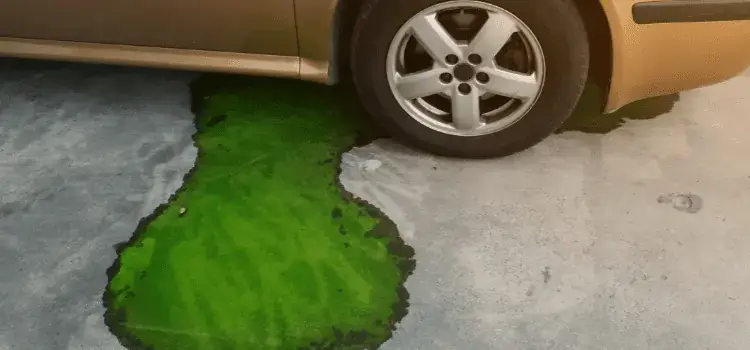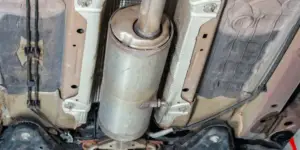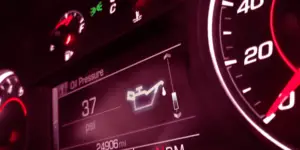Coolant is right up there with oil’s importance in keeping your car running smoothly.
When the engine is running, a car’s coolant is more prone to leak since it is hot and pressurized. A burst or cracked coolant connection, a leaky radiator, a leaking coolant reservoir cap, a faulty water pump, and a blown head gasket cause a coolant leak when an engine is on.
As your car heats up, the coolant gets hotter, expands, and pressurizes. Any fluid under higher pressure will put added stress on weak or loose components.
Seven major part failures cause coolant leaks while your car is running. Here we dive into what they are, how to solve them, and the fixing costs.
1. Radiator Cap Leaks
Over time a radiator cap can get worn out and weak – just like any other part of your car. This isn’t a problem when the coolant system isn’t pressurized but under pressure – which often exceeds 25 psi – average tire pressure! – it can leak.
The radiator cap contains rubber that can perish and harden, stopping it from sealing correctly.
In addition, the radiator cap works as a pressure release valve, and when it notices too much force within the system, it’ll open to let out excess steam and water. This saves other parts, such as the water pump or reservoir, from damage.
Solution
When the car is cold, unscrew the cap and inspect it. Does the rubber look stiff and inflexible? Is the cap valve operating incorrectly?
Cost to fix
A new radiator cap costs anywhere from $5 to $25. Expect to pay your mechanic between $10 and $50, depending on the model of your car. It’s a straightforward fix, though, so you shouldn’t need to employ one for this job,
2. External Leaks
You can identify this type of leak by checking underneath your car when the engine is running. Although you may also notice a small puddle without the engine, it’ll be far worse when the system is pressurized and your car hot.

The faulty part will likely be the radiator or the hoses taking the coolant to and from the radiator and engine.
Solution
Inspect your hoses for cuts, swells, or even roughness on the surface. Check if any coolant is leaking from the radiator and coolant tank.
Cost to fix
Depending on the type of car, replacing radiator hoses will cost you between $150 and $175, including labor. You can do this cheaply as the hoses only cost between $23 and $70, depending on what section needs replacing.
Many visitors also read this article: Don’t confuse this with aircon condensation leaking under your car Water Leak From Under Car When Air Conditioning Is On – Is It Normal? [Answered]
3. Internal Leaks
You will have a harder time identifying an internal leak since the coolant will probably not drip underneath your car.
It can be a bit of a head-scratcher when the radiator rapidly overheats, forcing you to add coolant constantly as it leaks away.
Pop the hood and look inside for moisture when the car is hot. Sometimes – on bad leaks – you can smell the coolant – it’s sweet – which may help you find exactly where the leak is coming from.
Solution
If you can’t see anything obvious, you should ensure that a certified mechanic examines your car to avoid damaging your engine.
Cost to fix
There is no direct answer concerning the price of fixing an internal leak since a wide range of problems might be at play.
It might be as cheap as tightening or replacing a hose clamp or as expensive as replacing the heater core.
4. Faulty Water Pump
The water pump ensures that coolant smoothly flows through all areas of the cooling system. The coolant will leak out if it breaks, gets a hole, or is loose.

Your engine will overheat after a while since the coolant is not moving through the system.
The water pump is located at the front of the engine and is driven by a belt from the alternator. They can leak when they get jammed when they get old. These parts usually last 80,000 miles before failing. Sometimes they’ll make a whining noise before they fail.
Solution
A new water pump will need fitting.
Cost to fix
A water pump cost’s between $200 and $326, and labor ranges between $200 and $300. In total, the cost is between $400 and $626
5. Blown Head Gasket
The performance of your engine is directly tied to your head gasket.
When a head gasket leaks, it can no longer separate the motor oil and the coolant. That’s why we refer to it as “blown.” A term that fills every motorist with dread.
A sure sign this has happened is that you see coolant leaking from the tailpipe and experience poor performance. Another tell-tale sign is the oil is a milky color, and the radiator or reservoir is bubbling.
Solution
It’s time to get to a mechanic. Driving your car with a bad head gasket will cause more damage and a more expensive repair bill.
Cost to fix
Repairing a blown head gasket will cost you $950 and $3400 at a repair shop.
6. Radiator and Radiator Hose Leaks
Unlike a radiator cap, radiator hoses account for the most external coolant leaks when your car runs. The hoses wear out and get weaker as time goes by as there are subjected to high temperatures and a harsh environment under the hood.

A radiator can also get a hole in it – it sits at the front of your car and can get hit by small stones.
Solution
Often a hose clamp may have come loose rather than a hose splitting. If the radiator is leaking, you have two options.
One is to replace the radiator, and the other is to try a radiator sealant. The sealant clogs a part of the radiator, making it less efficient. A sealant is bad for larger holes as it may leave the radiator unable to cool the system adequately.
Cost to fix
You can get a liquid sealant at any automotive parts store to fill tiny holes in the radiator for a price ranging from $5 – $15.
A new radiator – if needed – will cost anywhere from $300 to $500, including the price of the fitting.
A mechanic will conduct a pressure test to see where the leak is coming from and may use a dye to help.
7. Thermostat Stuck
If you have an engine light on, it’ll be worth plugging in an OBD reader to find out what error code is stored in the ECU. If you see P0128, that’s a sure sign the thermostat is either stuck open or shut. This can cause havoc with the coolant system and should be replaced as a matter of urgency.
Cost to Fix:
It’s an easy fix, though, which a basic car DIY’er should be able to do without a mechanic. Expect to pay between $80 and $220 for the part and another $50 for labor if you would rather visit a car shop.
In Conclusion
You see more leaking when your car is running because the engine is hot and under pressure; coolant is more prone to leak from a car when it is running. A burst or broken coolant hose, a leaky radiator, a leaking coolant reservoir cap, a damaged water pump, and a blown head gasket are the most common reasons of a coolant leak.



![Coolant Still Under Pressure When Cold [FIXED] radiator-cap](https://carzaza.com/wp-content/uploads/2024/02/radiator-cap-300x150.png)









